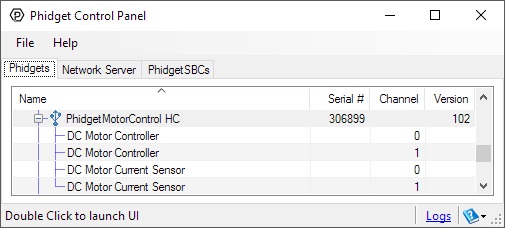1064 User Guide: Difference between revisions
No edit summary |
|||
| Line 1: | Line 1: | ||
[[Category:UserGuide]] | [[Category:UserGuide]] | ||
=== | |||
===Required Hardware=== | |||
* A PhidgetMotorControl HC | * A 1064 PhidgetMotorControl HC | ||
* A DC Motor | * A DC Motor | ||
* A 6 to 15V DC | * A 6 to 15V DC power supply | ||
* A USB Cable | |||
* A computer | |||
===Connecting the Pieces=== | ===Connecting the Pieces=== | ||
[[Image:1064_0_Connecting_the_Hardware.jpg|300px|right|link=]] | |||
# Connect the motor to the PhidgetMotorControl | # Connect the motor to one of the PhidgetMotorControl's outputs. | ||
# Connect the power supply to the terminal block on the | # Connect the power supply to the terminal block on the board. | ||
# | # Connec the Phidget to your computer using the USB cable. | ||
<br clear="all"> | |||
==Testing Using Windows== | |||
{{UGcontrolpanel|1064}} | |||
{{ | {{ugDCMotor}} | ||
{{ugCurrentInput}} | |||
{{ | {{UGotheros}} | ||
==Technical Details== | ==Technical Details== | ||
| Line 60: | Line 31: | ||
For more information about DC motors and how to control them, check the [[DC Motor and Controller Primer]]. | For more information about DC motors and how to control them, check the [[DC Motor and Controller Primer]]. | ||
{{UGnext|}} | |||
{{ | |||
| | |||
}} | |||
==Product History== | ==Product History== | ||
Revision as of 20:00, 29 August 2016
Required Hardware
- A 1064 PhidgetMotorControl HC
- A DC Motor
- A 6 to 15V DC power supply
- A USB Cable
- A computer
Connecting the Pieces
- Connect the motor to one of the PhidgetMotorControl's outputs.
- Connect the power supply to the terminal block on the board.
- Connec the Phidget to your computer using the USB cable.
Testing Using Windows
Phidget Control Panel
In order to demonstrate the functionality of the 1064, the Phidget Control Panel running on a Windows machine will be used.
The Phidget Control Panel is available for use on both macOS and Windows machines.
Windows
To open the Phidget Control Panel on Windows, find the ![]() icon in the taskbar. If it is not there, open up the start menu and search for Phidget Control Panel
icon in the taskbar. If it is not there, open up the start menu and search for Phidget Control Panel
macOS
To open the Phidget Control Panel on macOS, open Finder and navigate to the Phidget Control Panel in the Applications list. Double click on the ![]() icon to bring up the Phidget Control Panel.
icon to bring up the Phidget Control Panel.
For more information, take a look at the getting started guide for your operating system:
Linux users can follow the getting started with Linux guide and continue reading here for more information about the 1064.
First Look
After plugging the 1064 into your computer and opening the Phidget Control Panel, you will see something like this:

The Phidget Control Panel will list all connected Phidgets and associated objects, as well as the following information:
- Serial number: allows you to differentiate between similar Phidgets.
- Channel: allows you to differentiate between similar objects on a Phidget.
- Version number: corresponds to the firmware version your Phidget is running. If your Phidget is listed in red, your firmware is out of date. Update the firmware by double-clicking the entry.
The Phidget Control Panel can also be used to test your device. Double-clicking on an object will open an example.
DC Motor
Double-click on the DC Motor object, labelled {{{2}}}, in order to run the example: [[Image:{{{1}}}_DCMotor_Example.jpg|center|link=]]
General information about the selected object will be displayed at the top of the window. You can also experiment with the following functionality:
- Toggle the BackEMF Sensing checkbox to enable/disable back-EMF sensing on the {{{1}}}.
- Drag the Target Velocity slider from -1 (full reverse) to 1 (full forward) to make the motor move.
- Manipulate the Acceleration slider to increase/decrease the amount of time it takes the DC Motor to reach a target velocity.
Current Input
Double-click on the Current Input object {{{2}}} in order to run the example: [[Image:{{{1}}}_CurrentInput_Example.jpg|center|link=]]
General information about the selected object will be displayed at the top of the window. You can also experiment with the following functionality:
- Modify the change trigger and/or data interval value by dragging the sliders. For more information on these settings, see the data interval/change trigger page.
Testing Using Mac OS X
- Go to the Quick Downloads section on the Mac OS X page.
- Download and run the Phidget OS X Installer
- Click on System Preferences >> Phidgets (under Other) to activate the Preference Pane
- Make sure your device is properly attached
- Double click on your device's objects in the listing to open them. The Preference Pane and examples will function very similarly to the ones described above in the Windows section.
Testing Using Linux
For a general step-by-step guide on getting Phidgets running on Linux, see the Linux page.
Using a Remote OS
We recommend testing your Phidget on a desktop OS before moving on to remote OS. Once you've tested your Phidget, you can go to the PhidgetSBC, or iOS pages to learn how to proceed.
Technical Details
For more information about DC motors and how to control them, check the DC Motor and Controller Primer.
What to do Next
- Programming Languages - Find your preferred programming language here and learn how to write your own code with Phidgets!
- Phidget Programming Basics - Once you have set up Phidgets to work with your programming environment, we recommend you read our page on to learn the fundamentals of programming with Phidgets.
Product History
Template:UGhist Template:UGrow2 Template:UGrow Template:UGrow Template:UGrow2
